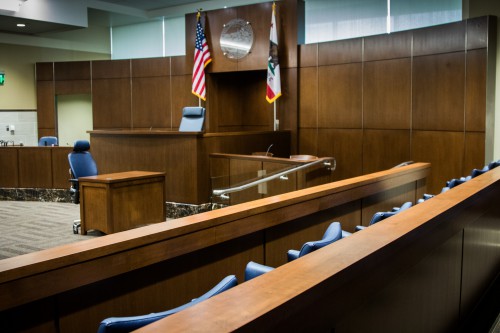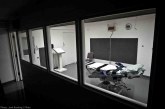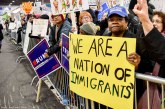 By Ruby Zapien
By Ruby Zapien
On February 10, 2017, in Department 9, the trial of the People v. Lance Ornellas-Castro reconvened. With the jury, defendant, and all counsel present, the People showed a series of surveillance video clips.
The clips were mute, and the court sat in silence as the videos played. These clips showed what appeared to be a busy convenience store parking lot. In the videos, one could clearly see a young man walk out of a vehicle and enter the store. This young man is later seen walking out of the store and wandering around the lot as if he is looking for something or someone. In the following clips, we saw this young man pacing the front of the store with his phone in hand, occasionally with his phone to his face as if he were on a phone call. The following fourteen clips were the various instances where the young man was seen walking in and out of the store from an inside camera. At one point, the videos showed what looked like the back of the store and two individuals walking along a fence, also looking for something or someone. Finally, the last two clips showed the original young man walking in and out of the store, this time with a companion.
At the conclusion of the final video, the People called Lisa Langford, a criminalist at the California Department of Justice in Sacramento, to the stand. On behalf of the People, Assistant Chief Deputy District Attorney Melinda Aiello questioned Ms. Langford on DNA and the process for analyzing it. Ms. Langford explained that approximately 99% of DNA for everyone is the same and it is about 1% of DNA which differs from person to person. She then went into detail on the four-step process of analyzing DNA: 1.Extraction; 2.Quantitation; 3.PCR, or making copies; and 4.Analyzing and interpreting results.
This was the process Ms. Langford used in December of 2015 to analyze the data on certain items in this given case. These items consisted of a pair of Banana Republic jeans, a Red Bull can, a bag containing possible blood, possible hair and possible brain matter, and a swab of possible blood from the center console of a car.
Ms. Langford continually used the terms “included and excluded.” Ms. Aiello then asked what the difference was between a match and being included. Ms. Langford replied, “They’re the same.”
Ms. Aiello then asked who was included or excluded from the items in this case. From the Red Bull can, both Jorge Garcia and Andrew Phaouthoum were excluded. Ms. Langford described her process for swabbing the Banana Republic jeans, and the six locations swabbed were the ankles, front and back, and the back of the knees.
When questioned on her methods, Ms. Langford reasoned, “Trying to, based on case scenario, see if there was any DNA of anyone who touched or dragged the jeans.” Based on these six swabs, five out of six were a presumptive positive for blood. However, the blood held a mixture of three samples, and the mixture was too difficult to interpret. Deputy Public Defender Dan Hutchinson, on behalf of the defense, asked to approach the bench. The Honorable David W. Reed and counsel spoke for a brief moment, and Judge Reed gave Mr. Hutchinson some time to research. Judge Reed read to the jury from a book written by John Wooden while the court waited. Finally, Ms. Aiello, in agreement with Mr. Hutchinson, brought the court back to the original matter at hand and jokingly said, “Maybe this is more interesting than DNA, but I don’t know.”
The People continued talking about the additional items examined in January of 2016, including a pair of safety glasses and a buccal swab from Mr. Ornellas-Castro. On the safety glasses, the results showed a low-level mixture of at least two individuals, and Ms. Langford was not able to include or exclude anyone.
Questions followed from Mr. Hutchinson.
“When you performed tests on the Red Bull can and brain matter, that was in December of 2015?”
“I believe so…yes.”
“You didn’t have a sample from Lance Ornellas-Castro in December of 2015, but you did develop a profile from the Red Bull can?” asked Mr. Hutchinson. To that, Ms. Langford affirmed, and reaffirmed she could not exclude Andrew Phaouthoum or Jorge Garcia from the can.
After confirming that Ms. Langford developed a profile from Mr. Ornellas-Castro, Mr. Hutchinson asked about his profile in comparison to that from the Red Bull can. Ms. Langford answered, “He was not a match.”
With no further questions for Ms. Langford, Deputy District Attorney Matt De Moura, on behalf of the People, called Angela Stroman to the stand. Ms. Stroman is also employed as a criminalist for the Department of Justice for Sacramento County.
Mr. De Moura asked, “What is it called when trying to match bullets to a firearm?”
“Firearm and tool mark identification and examination,” answered Ms. Stroman.
“What if a gun was not recovered, can you liken the bullet to a gun type?” asked Mr. De Moura. Ms. Stroman briefly talked about a General Rifling Characteristics Database that could give a list of firearms that match the characteristics of the bullet.
Mr. De Moura then asked if Ms. Stroman did any analysis on two recovered bullets about this case and whether or not they were the same type of bullet, same caliber.
“They appeared to be, yes.” answered Ms. Stroman.
Ms. Stroman then went on to describe the list of guns from which the bullets could have been fired. Based on the results from the General Rifling Characteristics Database, they could have been fired from a .38 Special, a .38 Smith and Wesson or a .37 Magnum. Ms. Stroman also clarified that this list is not all-inclusive. Although the FBI frequently updates the list, it is not updated daily.
Mr. De Moura then asked Ms. Stroman about her familiarity with the gun brand Taurus, and if the bullets she analyzed could have been fired from one of that brand’s guns. Ms. Stroman confirmed that this was possible.
The next witness called by the People was Lauren Doane a Crime Scene Investigator for the Yolo County Sheriff’s Office. Ms. Doane is an expert in fingerprint analysis.
Ms. Doane stood and showed the jury a chart depicting three general types of fingerprints: loops, whirls, and arches, claiming these are the “beginning phases of identifications.”
Mr. De Moura asked if everyone has all of these characteristics.
“You may have some. None. Everyone is different,” answered Ms. Doane.
Mr. De Moura then asked what a “usable print” is. To that, Ms. Doane replied that a usable print has enough detail to recognize, but not enough to make an identification.
Moving on to the six fingerprints in exhibits marked Prints A-E, Mr. De Moura asked Ms. Doane what her findings were.
Print A was identified to the right middle finger of Jorge Garcia. Print B was usable, and eliminated Andrew Phaouthoum but could not eliminate Jorge Garcia. Print C was another usable print, but had not enough detail to eliminate Andrew Phaouthoum or Jorge Garcia. Print D was identified as Jorge Garcia’s left middle finger. Finally, Print E was identified as Jorge Garcia’s left middle finger.
The defense then cross-examined and questioned Ms Doane about Print C, asking her to confirm that she could not eliminate Jorge Garcia and Andrew Phaouthoum because they had a similar pattern. Ms. Doane simply answered, “Yes.”
“How common is that?” asked Mr. Hutchinson.
“In that case, a loop, 60% of the population has that characteristic.”
The next witness was Mr. John Sadlowski, a Yolo County District Attorney’s Office investigator in the High Tech Unit.
Mr. Sadlowski was asked about phones pertaining to this case. Mr. Sadlowski mentioned an LG phone, a Samsung Galaxy, and an iPhone 5C. Mr. Sadlowski was able to extract data from all of these.
Mr. De Moura asked if any other phones were collected and examined related to this case.
“Yes, five other phones,” answered Mr. Sadlowski.
Mr. Hutchinson, for the defense, asked to go over the five additional phones that were examined, slowly. Mr. Sadlowski mentioned another iPhone 5C that could not be extracted because it was remotely reset. Following that iPhone 5C was an Alcatel One Touch 505, a different Samsung, an iPhone 4, and a Motorola 360.
The final witness for the day was a sibling of Mr. Jorge Garcia, hereinafter referred to as “JG.” JG is a senior in high school with the hopes of attending college to study architecture and graphic design.
Ms. Aiello asked about Jorge Garcia’s working hours.
“He would leave around five-ish and be back around five-ish or four-ish,” answered JG.
Regarding the night of December 11, 2015, “Did something wake you up?” asked Ms. Aiello.
“Like a car,” said JG.
“Did you assume it to be your brother?” Ms. Aiello continued.
“Yes.”
“Why?”
“Because the dogs didn’t bark,” said JG.
The following line of questions was regarding Jorge Garcia and whether or not he obtained a new phone. JG claimed he did not know, that his brother never mentioned it. However, when JG was asked if he received a text from Jorge Garcia, saying “this is my new number,” JG said he did receive such text.
Mr. Hutchinson then questioned JG on which cars his brother Jorge Garcia regularly drove and whether JG had a driver’s license at the time. JG answered, “No, I still don’t.” Finally, Mr. Hutchinson asked if Jorge Garcia has a nickname.
“Yeah, he calls himself Solo,” replied JG.
When the jury was released for lunch, Judge Reed explained to both counsel that the scope of inquiry to Jorge Garcia would be limited to whether or not he had any knowledge of Mr. Rod Beede, Garcia’s attorney, talking to others. Content and details of what happened in this case were not to be an open inquiry. Finally, Judge Reed planned to inform Mr. Beede that he will not be in the courtroom during Mr. Garcia’s testimony.
Upon return from lunch, Judge Reed instructed the jury that the court would be watching a video of the interview on January 19, 2016, shortly after Mr. Ornellas-Castro’s arrest. Detective Young, who conducted the interview, will be called to testify at a later date.
The video began with Mr. Ornellas-Castro with a shaved head, wearing a red 49ers shirt and red shorts, sitting alone in handcuffs and fidgety before Detective Young entered the room.
Detective Young advised Mr. Ornellas-Castro of his rights and continued to tell Ornellas-Castro, “We’ve been talking to Jorge, this is your chance to tell us your side of the story… do you know what I’m talking about?” Mr. Ornellas-Castro was seen shaking his head.
Detective Young proceeded to ask Ornellas-Castro about his relationship with Jorge Garcia.
“Ever know Jorge to smoke weed with Asian guys? Ever pretend to buy and then rob?” inquired Detective Young.
Mr. Ornellas-Castro responded, “I wouldn’t know. Don’t think we’re tight like that.”
Detective Young brought up text exchanges between Jorge Garcia and Mr. Ornellas-Castro about being paranoid. “Why would he text you this?” asked Det. Young.
“I don’t think he would text me that,” answered Mr. Ornellas-Castro. At this point in the video, Ornellas-Castro appeared defensive and asked, “So I’m being charged or something?”
“Yeah, you’re being charged with murder,” responded Detective Young.
Mr. Ornellas-Castro then said, “I don’t see how this is pointing to me.”
After discussing the text messages again, Mr. Ornellas-Castro reaffirmed they could not have been from him, due to his phone being cut off. Detective Young asked Ornellas-Castro about his work glasses and badge.
“He has them. I never take them home. I always leave them in his van… If I didn’t leave it with him, I’d probably forget it,” answered Ornellas-Castro.
“Any idea why your glasses would be at a crime scene?”
“Nah,” responded Mr. Ornellas-Castro.
“Everything is there,” stated Det. Young.
Mr. Ornellas-Castro raised his voice, “I don’t see how everything is there, but if he’s saying it, what am I supposed to do?”
Det. Young continued to push on the topic of the text messages found on Mr. Garcia’s phone. However, after Mr. Ornellas-Castro was told he was being booked, he asked for a phone call to contact his family for an attorney.
Detective Young re-entered the room, alone. He wanted to talk to Mr. Ornellas-Castro about waiving his rights and discussing some items found in his home, particularly a receipt for a Taurus gun.
Mr. Ornellas-Castro began to give his rendition of the night of the incident.
“We went to pick up weed… he didn’t give us the right amount, and he flipped like he was going to pull something out,” Ornellas-Castro said as he gestured his hand toward his hip. “I’m trained to do this… That’s what happened, and that’s what happened. I just reacted. I didn’t have time.”
When asked what Jorge Garcia’s reaction was, Mr. Ornellas-Castro said, “He panicked, he drove off.”
“You pulled out your pistol and shot him twice?” asked Detective Young.
“I shot once, so we pulled over, pulled him out of the car and he started moving.”
“So you shot him again? Where did you shoot him the second time?” inquired Det. Young.
“In the head,” recalled Ornellas-Castro.
The family of the victim, at this point, could not hold back their emotions, and tears began to run down their faces as they listened to how Andrew Phaouthoum was murdered.
After telling Det. Young that the murder weapon was thrown in a river, Young said to Ornellas-Castro, “Here’s the thing, you’re coming out and being honest. People understand you were in Afghanistan… you’re not going to be judged the same as anyone else.”
“I just feel like I am, Jorge didn’t really do it, it’s really me looking at the time,” responded Mr. Ornellas-Castro.
Detective Young asked about the gun again. “I didn’t want to do anything ever again, so I threw it in the river,” stated Ornellas-Castro. Det. Young then tried to review the event.
“If you never robbed before and you go out to buy marijuana from this guy. You don’t even know this guy. You guys had money/cash.”
Mr. Ornellas-Castro interrupted to mention that he had fronted Mr. Garcia the money in order to turn around and sell the weed because he needed the money for rent.
Detective Young continued, “You said [Andrew Phaouthoum] was talking smack?”
Ornellas-Castro answered, describing what the victim had said,“’Nah… What the F—… Nah that’s what you got.’ When we told him to give us back the money, he said ‘Nah F— that.’”
“Basically you felt like Jorge’s life, and your life was in danger?” asked Det. Young.
“Yeah.”
Detective Young continued, “You were in war as a combat engineer, maybe that’s where all of that was coming from.”
“Yeah,” said Ornellas-Castro.
The two then spoke more about Mr. Ornellas-Castro’s experiences at war and his upcoming appointment for a mental evaluation.
Judge Reed ordered to stop the video at 4:00 P.M. and advised the jury not to return on Monday, February 20, due to the court holiday.
The trial will resume Tuesday, February 21, 2017, in Department 8.




